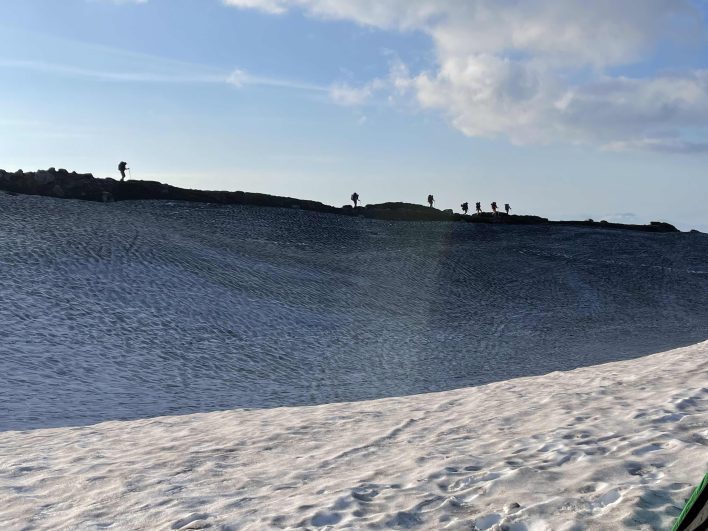When I look back on living in Oregon, spring skiing rises to the surface of my many cherished memories—the kind that have become fuzzy around the edges, the details vague, the feelings amplified. Oregon’s Cascades feature glaciated routes, but what I remember most are long, fast corn runs off the summit of South Sister and Mt. Hood with easy routefinding and low crevasse danger.
In pursuit of new memories, ones with a bit more spice, this past weekend I joined a Mountain Madness ski mountaineering course on northern Washington’s Mt. Baker. We ascended and skied the Easton Glacier route, which features ever-present crevasses and icefalls from the moment you step foot on the glacier after leaving camp. The corn, like in my previous recollections, was fantastic, but as time passes and this memory fades, it’s the glacier travel mindset—descending while keeping an eye out for trending crevasses and stopping often to scout the rollovers below—that I’ll remember from this trip.
In courses, it’s easy to get caught up in the hardskills, instead I’d like to share the human factors I learned about. If you live in the Northwest, there’s still time to hop on a course this spring, but regardless, these tips will serve you well whenever you may pull the trigger.

The author’s group skins up Mt. Baker’s Easton Glacier route. [Photo] Tom Hallberg
Train
Ski mountaineering is hard, and catching safe, quality conditions requires timing. Both of my peers on the course had trained in some way, but they had done very few 5,000-foot, 10-hour days and both found their pace slowing as we approached the summit crater. Over beers in Mount Vernon afterward, we discussed how to get in shape for a course like this. Our guide advised that there’s no substitute for long days on-trail. So, as much as you can, go for half-day skins or even multihour hikes if you live somewhere without a lot of snow, just so your body knows what it’s like to be out for that long of a day.
Be Humble
We could all take this succinct advice from Kendrick Lamar. Though I’ve done little glacier travel, I have spent hundreds of days in the backcountry and led winter camping trips for a couple of years. As a result, I approached the packing and camping side of my course with a bit of a laissez-faire attitude. When I couldn’t fit my tent inside my pack, I lashed it to the side. “Just make sure that’s tied on somehow,” our guide said. I nodded but didn’t actually follow through, instead depending on the cinch straps alone. When we arrived at camp, my poles had slid off my pack somewhere on the summer trail; I spent an hour rigging a trucker hitch system to keep it upright.
Still, the tent still sagged and was closer to a bivy than I would have liked. On top of that snafu, our guide, who had more than 100 ascents of Mt. Baker and years of experience, lost all of his food to a marmot or raven that undid the knot on his supposedly critterproof food bag. Luckily, we had enough extras to share with him, and some kind soul found my poles and dropped them at the trailhead, but it was a subtle reminder. No matter your experience, stay humble—we never stop learning and sometimes the advice you ignore comes back to bite you.

Crevasse rescue practice is easier when one isn’t actually in the crevasse. [Photo] Tom Hallberg
Know What You Want to Learn
Brian Muller, lead guide for Mountain Madness and our trip leader, left much of the course up to us. We reviewed glacier travel, crampon use and other requisite skills for making our way up Baker, but with our time at camp each night, he asked us what we wanted to learn. That allowed us to go over crevasse-rescue haul systems, something that’s not on every three-day course syllabus. So, going into things knowing what you want to learn can help make the most of your guide’s knowledge.
Ask Lots of Questions
You’re going to have an abundance of time on the skintrack, especially if you’re on a volcano mission like I was. The walks are long, and perfect for chatting. Instead of making small talk, use the time to ask more about the skills you’re interested in. Brian answered my questions about rappel anchors, when to use ropes (or not) and shared other ski mountaineering insight that might not come through in a strict lesson format.

Descending climbers pass by the author’s camp as the sun rises. [Photo] Tom Hallberg
Keep Expectations in Check
This goes hand in hand with the avalanche-safety lesson to be wary of summit fever: don’t necessarily have the summit as the ultimate goal. My hope from any course is to be able to take the knowledge and apply it to become more sufficient and independent when I return to the backcountry without guides. We did summit Baker (the Roman Wall had awesome skiing), but one guy in our party had to stop at the summit crater because of knee pain. Those things happen in the mountains, and if you focus more on the idea that you’re developing self-sufficiency rather than completing an objective, you won’t feel pressured to push through challenging weather, conditions or injury in the moment.
Tom Hallberg is the managing editor for Backcountry Magazine. Born and raised in Oregon, he now resides in Teton Valley, Idaho, but returns home to the Cascades when the corn is ready to harvest.










Related posts: